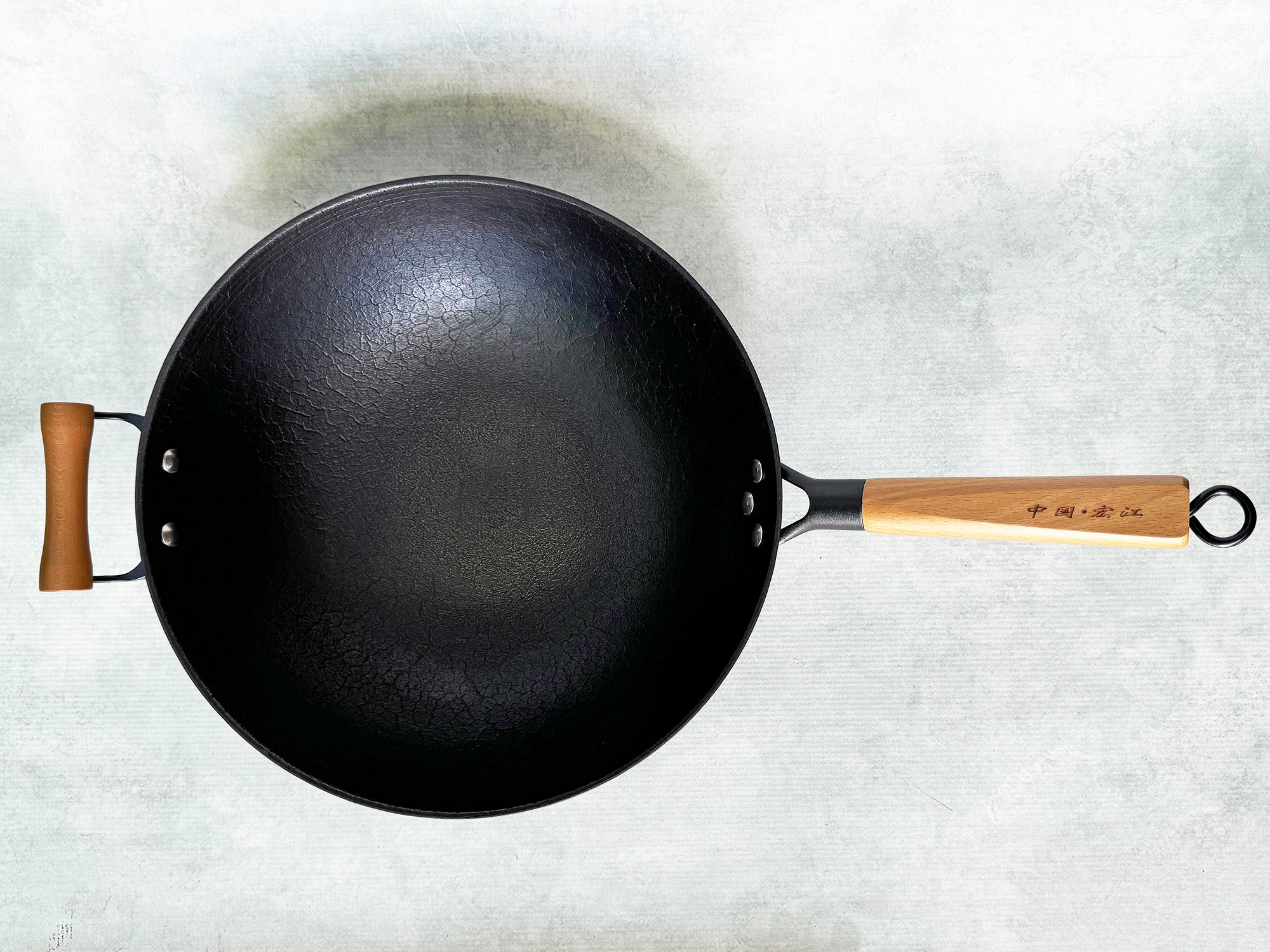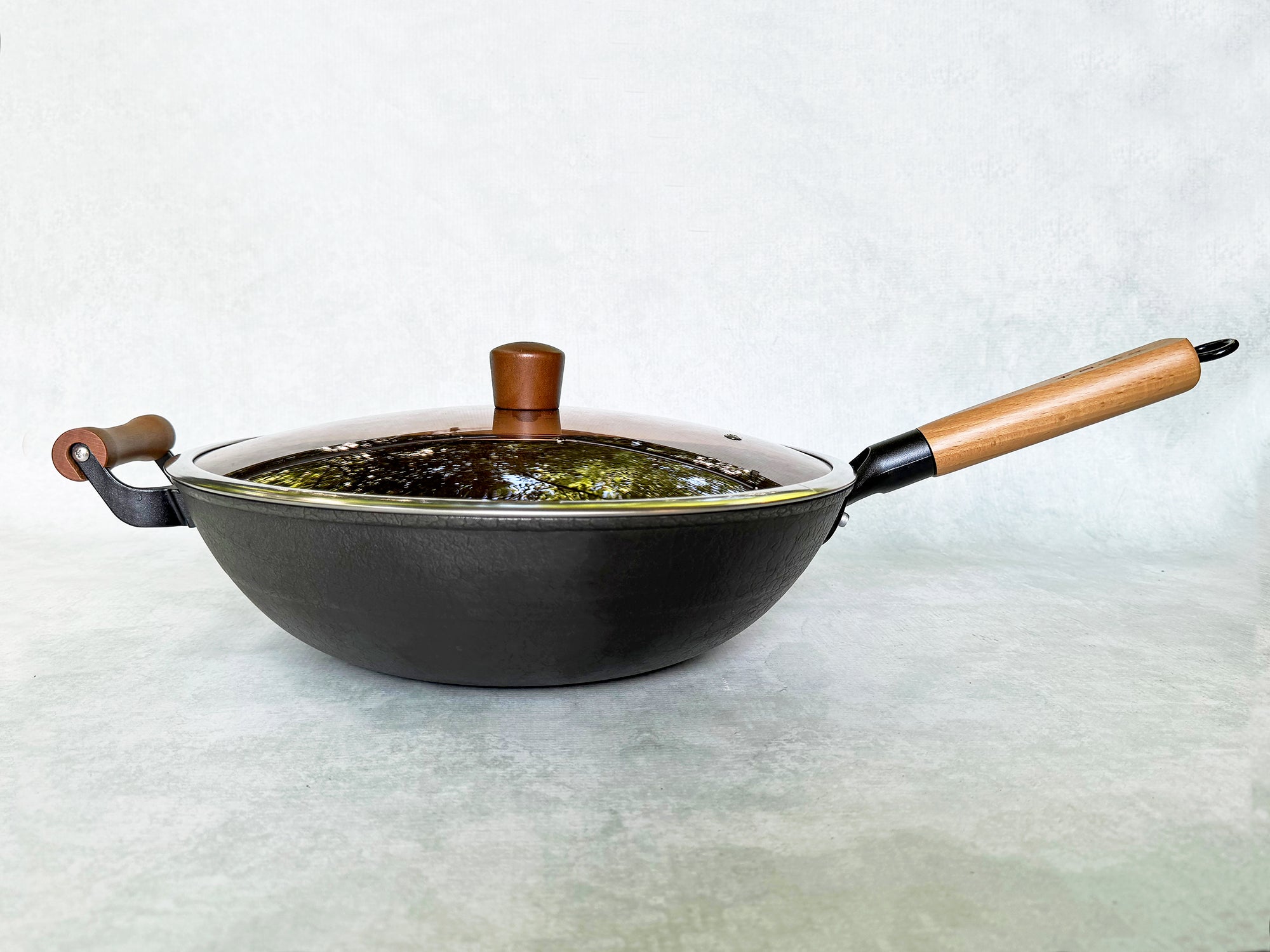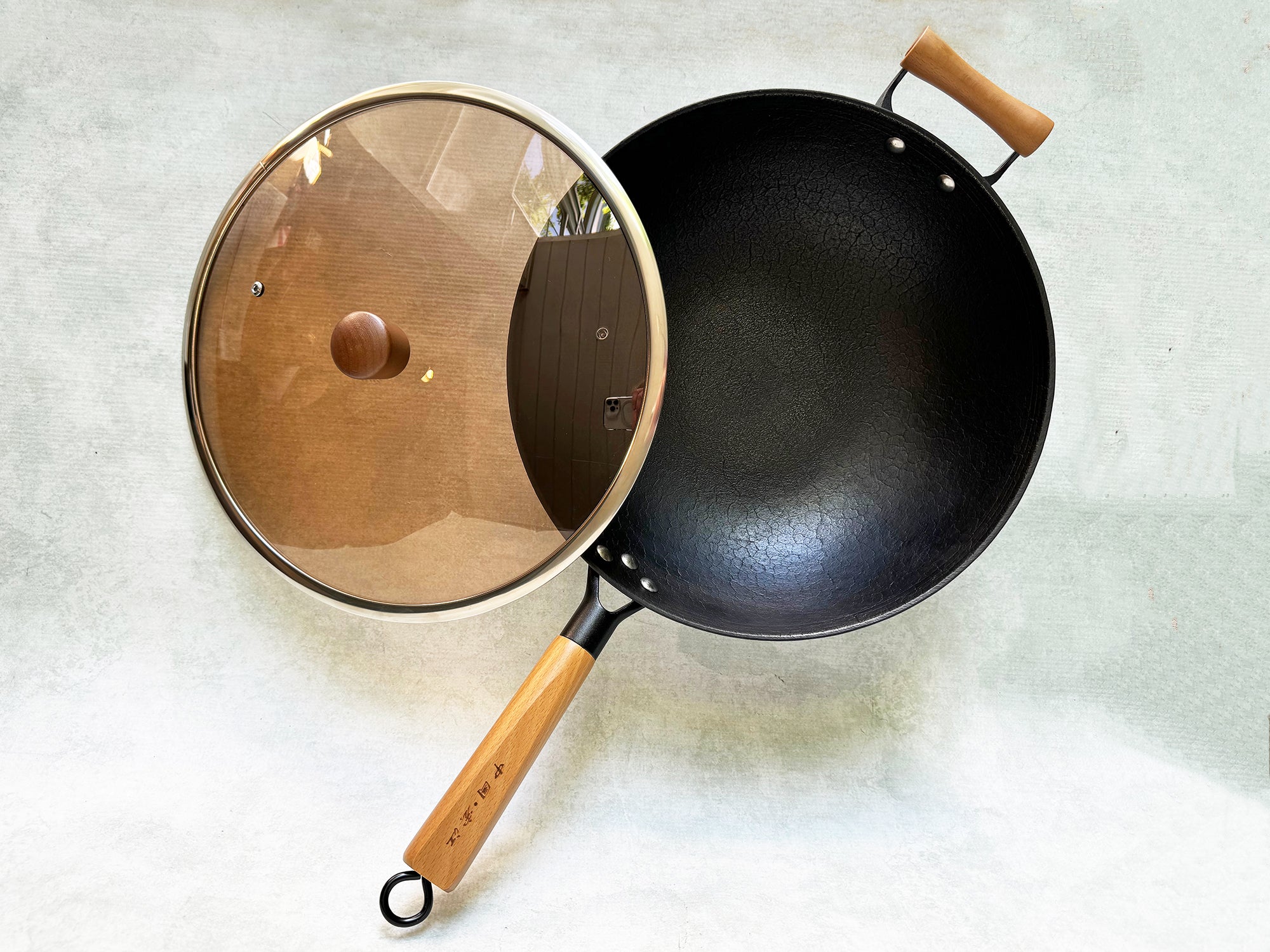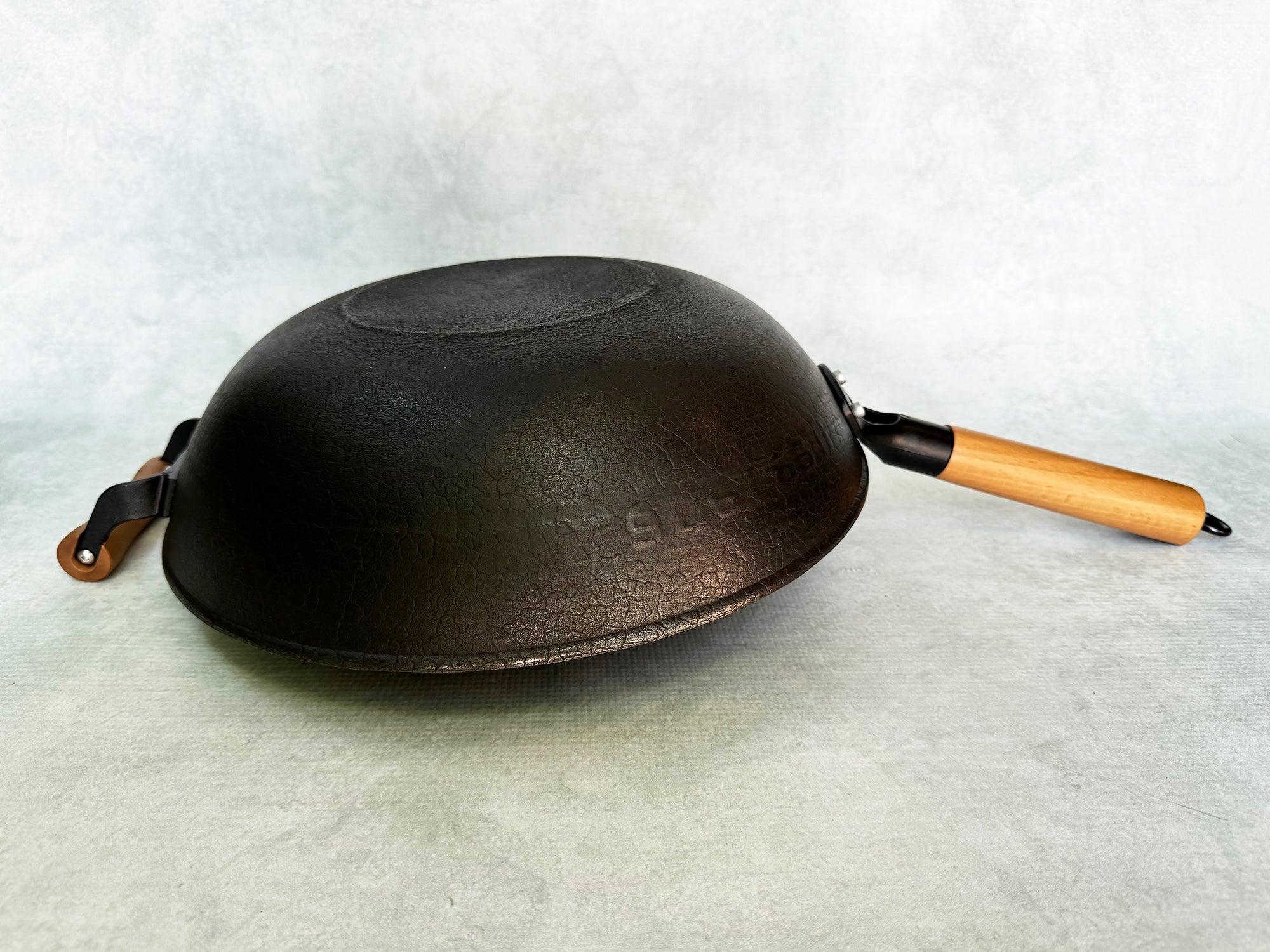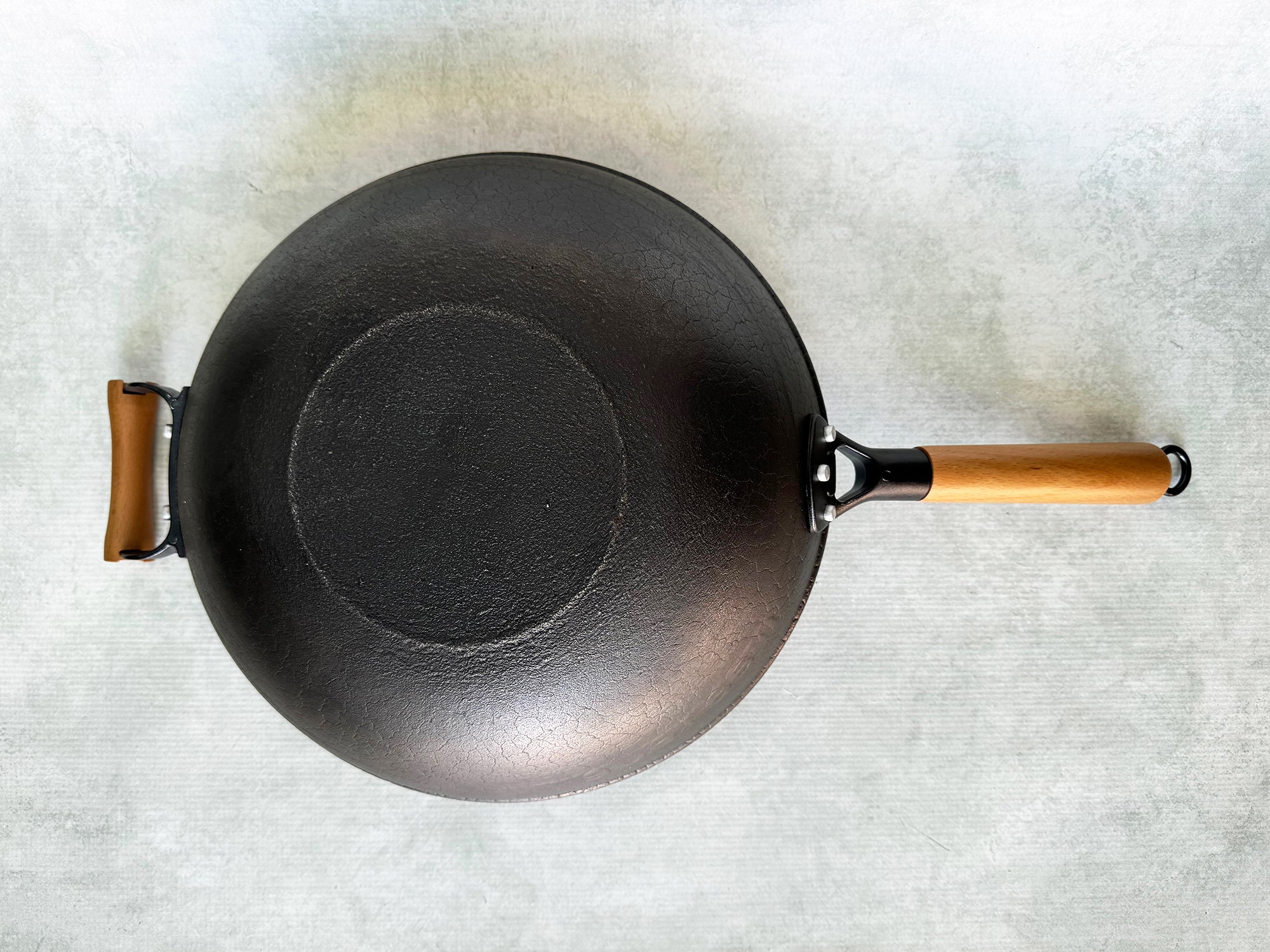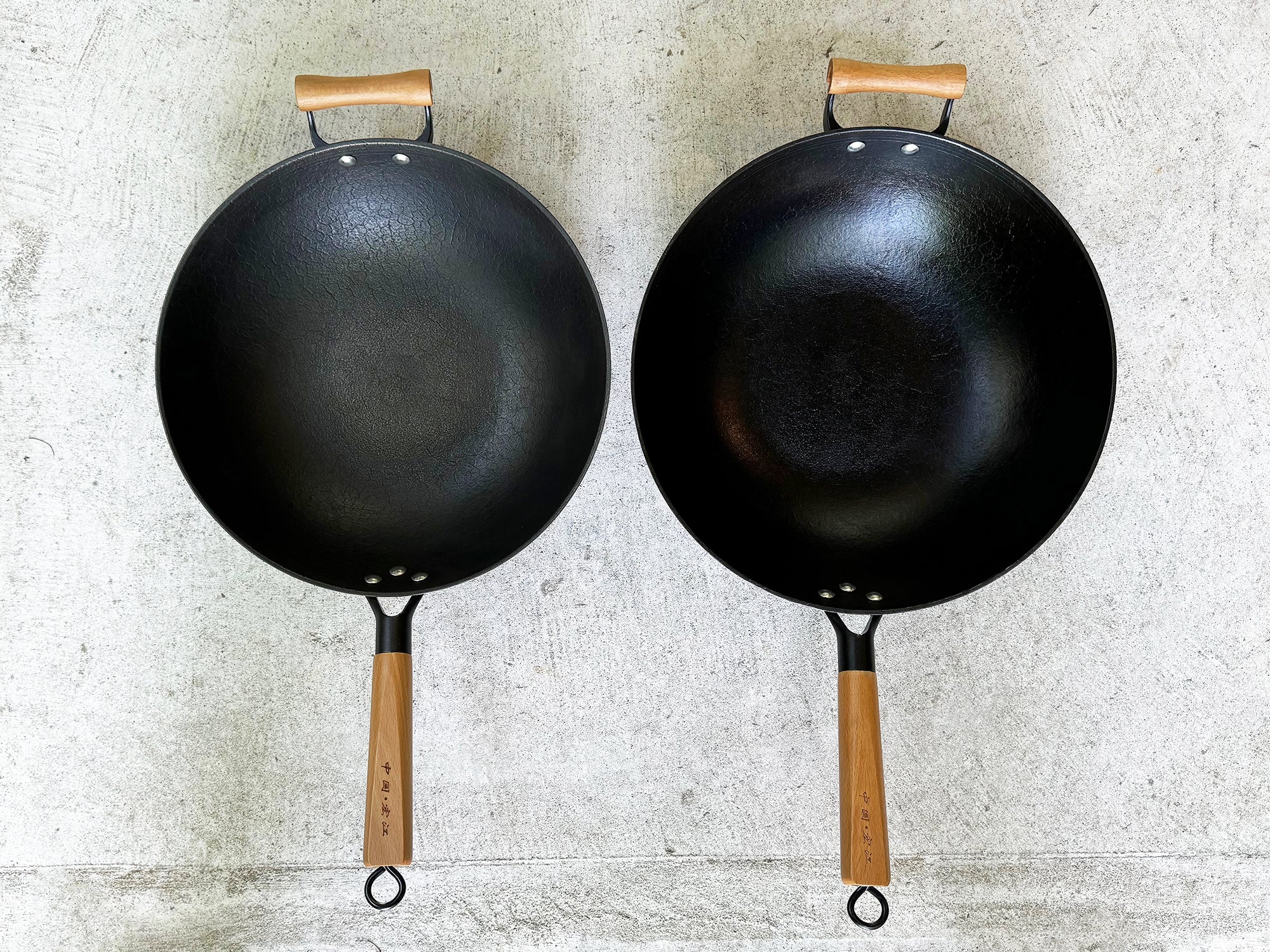Lightweight 13.5-Inch Flat-Bottom Cast Iron Wok With Glass Lid
$150
Please read description and size carefully. The 14.5-inch version of this wok is the most popular, but if you have a small kitchen/cooktop or cook for only 1-2 people this 13.5-inch wok may be preferable and is still plenty large for real stir-frying. See photos for size comparison. Returns will incur a restocking fee.
If you love cooking in cast iron skillets or dutch ovens, you are going to love cooking in a cast iron wok just as much. And because it is lightweight Sichuan cast iron, you don't have to worry about the one and only downside to cast iron cookware, which is weight.
Wok pros in the U.S. are unanimous in recommending a 14-inch, flat-bottom, carbon steel "pow" wok, with a long handle and a helper handle. We agree with all of that except that a wok must be carbon steel.
It's true that American-made cast iron is very heavy, with the wok made by the best known brand weighing in at nearly 13 pounds! But Chinese cast iron weighs a fraction of what American does—our 13.5-inch, flat-bottom pow wok weighs only 4 pounds, directly comparable to good carbon steel woks. (And no, it is not thin and fragile. Read more on that below).
This wok is made by a company that has been making iron pots for more than a century in Sichuan, where it has Intangible Cultural Heritage status. Just as cast iron skillets were beloved by generations of Americans before us, the same is true in China, where the cast iron wok was the original wok, beloved by home cooks for centuries. (Typically a very large cast iron wok set into a hearth with a fire burning beneath it.)
Why we love this cast iron wok
We used this wok almost daily for six months before we committed to it as The Mala Market wok. Here is what we learned.
Chinese cast iron is ideal for stir-frying: This wok heats up exceptionally fast and retains heat longer than any other material. This is important because the goal of stir-frying is to cook ingredients quickly, searing and crisping proteins while retaining the crunch of vegetables. We tested this, and water came to a boil faster in this wok than in our thin, carbon steel Cen wok! Even more importantly, adding ingredients to this wok does not significantly lower the temperature, as it does in other materials, allowing you to stir-fry the entire dish over sufficient heat, even with the lower BTUs of a home stove. This sustained high heat makes possible the Maillard reaction (browning) and wok hei (the transference of the breath, or essence, of a wok to the food).
This wok is compatible with all cooktops, including gas, glass/ceramic, electric coil and induction. However it, like all woks, works best on gas stoves.
The right size and shape: Unless you have a built-in wok burner on your cooktop or another setup you are comfortable with, a flat-bottom wok is better than a round bottom for Western stoves.
Note: For those with a wok grate, we also sell this wok in the traditional round-bottom style.
The size and shape of a wok are also important. Woks need to be at least 13 to 14 inches in diameter to provide ample space for stirring, flipping and tossing food. Woks that are under 13 inches in diameter are simply not large enough for serious stir-frying, as the food is crowded in the wok, causing it to steam instead of fry. Similarly, the flat bottom of the wok needs to be large enough to connect directly with the heat source and heat the entire wok. The flat bottom of this pan measures almost 6 inches, providing that contact. High sides are necessary for maneuvering the ingredients and providing multiple heat zones. This wok is 3.75 inches deep.
Finally, a pow wok has a long handle, vs. the Cantonese wok with two ear handles, which makes it easier to lift and maneuver. The handle and helper handle on this wok are natural oak.
Real talk: A 4 pound wok with a pound of food in it, whether that is a cast iron or a carbon steel wok, is too heavy for many of us to toss around like a Cantonese restaurant chef. No matter. If a full wok is too heavy for you to lift and toss, simply stir-fry the way Chinese home cooks do, using a wok spatula/shovel to scoop, toss and move the food through the heat zones. We recommend a wood wok spatula such as this one for a quieter, more pleasant experience than a metal spatula.
Lid: This wok comes with a gold-tinted tempered-glass lid that fits tightly to the wok to facilitate steaming and braising.
Nonstick surface: When molten pig iron ore is cast in a clay mold in the Chinese process, thermal expansion and contraction creates a "turtle pattern," with small irregular lines all over the surface. These shallow cracks trap oil that becomes polymerized and creates a very effective nonstick surface.
Preseasoned: After the factory pros sand and finish the wok, they preseason it for you. Per their instructions, and our experience, there is very little you need to do to get started cooking in this wok. The pot does not have a coating to remove. They advise that you heat the wok over high heat for one minute, then while the wok is hot, carefully wipe it clean with a damp cotton cloth. Wash out the cloth and thoroughly wipe the wok three times. When the wok cools, simply apply a thin layer of oil all over the inside and outside of the wok with a paper towel. And that is it!
Usage: The keys to nonstick cooking are sufficient heat and oil. The makers advise heating the wok over high heat for 1 to 1 1/2 minutes, at least until there are visible wisps of heat, then lowering the heat and adding the oil. For the first few uses, make sure you are generous with the oil, to build up the nonstick surface. After you've built up that surface, you will need less oil for nonstick cooking.
The company also advises not to boil or braise foods for the first month or so, allowing that nonstick surface to form from cooking in oil. Use little or no soap to clean the wok during this early stage. Simply use hot water and a dual-sided sponge. After the nonstick surface has formed, it's fine to use small amounts of dish soap. Completely dry the wok after each use. If the surface has an oil sheen, no need to oil. Otherwise, coat the inside surface with a thin layer of oil before storing it.
As you use the wok, the non-cooking surface around the top edges can get an oil build-up. The company advises using steel wool to clean that area or any area with noticeable cooked-on grease. You can also use steel wool to remove rust if you don't dry it well. We have found it much easier to keep this wok clean than our carbon steel woks.
Longevity: U.S. wok pros warn that Chinese cast iron is fragile and can easily break. We have certainly not found that to be the case with this wok, perhaps because the manufacturing process has been improved or just because it is sufficiently thick-walled. We took our sample wok and threw it on the concrete sidewalk several times, then struck it against a concrete corner several times, with absolutely no harm to it. Having said that, if your wok breaks with normal usage, we'll replace it.
Aesthetics: We have saved one of the best attributes of cast iron for last. The cooking surface is an attractive all-over gray-black from day one. Unlike carbon steel, which has an extremely long ugly duckling stage (usually a year or more) of mottled blacks and browns as the seasoning builds up, the surface of cast iron will quickly build a black patina. It looks so handsome on the stove, you may just keep it there.
See this wok in a 14.5 inch diameter
See this wok with the traditional round bottom
See a hand-carved wood wok spatula
Returns: Please read product description and size carefully, as all cookware returns incur a restocking fee.
Dimensions: 13.5 inches diameter at top; 5.75 inches diameter flat bottom; 3.75 inches tall; weight without lid 4 pounds
Materials: high-quality cast iron body; natural oak wood handles; gold-tinted, tempered-glass lid trimmed in steel.
- This wok is compatible with all cooktops, including gas, glass/ceramic, electric coil and induction. Like all woks, it works best on gas stoves.
- The wok ships with the long handle detached. Simply screw the handle into the wok with your hands. No tools needed.
Share:


